
| Palaeos: |  |
Reptiliomorpha |
| The Vertebrates | Embolomeri |
| Page Back | Unit Home | Unit Dendrogram | Unit References | Taxon Index | Page Next |
| Unit Back | Vertebrates Home | Vertebrate Dendrograms | Vertebrate References | Glossary | Unit Next |
|
Abbreviated Dendrogram
TETRAPODA |--TEMNOSPONDYLI `--+--LEPOSPONDYLI `--REPTILIOMORPHA |--Anthracosauroidea | |--Embolomeri | | |--+--Proterogyrinus | | | `--Pholidogaster | | `--Eogyrinidae | | |--Diplovertebron | | `--Pholiderpeton | `--Chroniosuchia `--+--Gephyrostegidae `--Batrachosauria |--Seymouriamorpha `--+--Solenodonsaurus `--Cotylosauria |--Diadectomorpha `--AMNIOTA |
Contents
ReptiliomorphaEmbolomeri Chroniosuchia Gephyrostegidae Seymouriamorpha Diadectomorpha Dendrogram References |
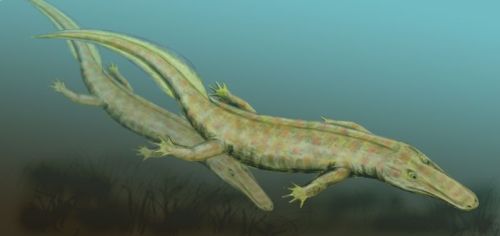
 Embolomeri:
Archeria, Pholiderpeton, Proterogyrinus.
Embolomeri:
Archeria, Pholiderpeton, Proterogyrinus.
Range: Early Carboniferous to Early Triassic (fl. Late Carboniferous) of North America, Europe (Scotland) & Russia.
Phylogeny: Anthracosauroidea : Chroniosuchia + * : (Proterogyrinus + Pholidogaster) + Eogyrinidae.
Characters: Specialized, long-bodied, piscivorous marine anthracosaurs; short skull table with kinetic line [C02]; prominent tabular horn [C02]; cheek extends well posterior to occiput [C02]; very loose junction between quadrate and quadrate ramus of pterygoid [C02]; elongated trunk (e.g. 40 vertebrae); both pleurocentra and intercentra developed as cylinders; some with caudal fin (i.e. caudal supraneural radials as in fish) [C02].
Image: Proterogyrinus scheeleri from Holmes (1984).
Note: see figure and note under Anthracosauroidea.
Links: Phylogenetic position of the Embolomeri; Biology 356; Phylogeny of stegocephalians; Embolomeri.
References: Clack (2002) [C02]. ATW020128.
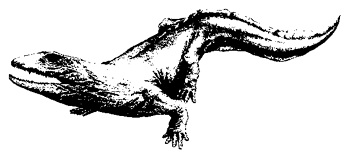 Proterogyrinus:
P. pancheni Smithson 1986; P. scheeleri Romer 1970.
Proterogyrinus:
P. pancheni Smithson 1986; P. scheeleri Romer 1970.
Range: Early Carboniferous of North America & Europe (Scotland).
Phylogeny: Embolomeri :: Pholidogaster + *.
Characters: kinetic line present; neck short; 32 presacral vertebrae; vertebrae not fully embolomerous (see figure at Anthracosauroidea); tail laterally flattened; phalangeal formula 23453;
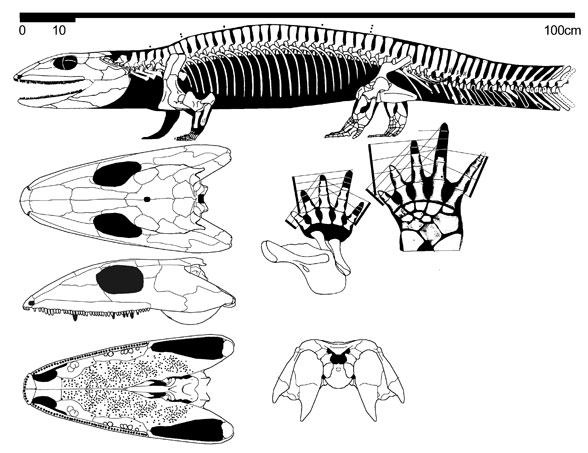
Note: [1] Proterogyrinus was a primitive semi-aquatic embolomere able to manage well both on land and in the water. It had well-developed limbs and a short neck and relatively short trunk, with 32 presacral vertebrae. The tail is flattened to aid in swimming. As with lobe-fined fish (osteolepiforms), there is a line of weakness between the skull table (the flat area at the back of the skull) and the cheek area, which allowed the skull to flex during jaw-opening. A notch at the back of the skull may have contained an eardrum, but the large bladelike stapes of primitive anthracosaurs are quite different to the narrow rod-like structure of animals with an ear adapted to detected sound in air. P. pancheni is the Scottish form, known from both the Dora Bone Bed near Cowdenbeath, Fife and the Lothian Region. P. scheeleri (see figure above, at Embolomeri) was recovered from the Bickett Shale, Bluefield Formation from Greer, West Virginia, USA. Both are of Serpukhovian age, although the American form is somewhat older. MAK981010. [2] note the still somewhat fish-like tail in the figure at Embolomeri. Clack (2002) compares this structure to Eusthenepteron and Acanthostega to make the argument that the transformation proceeded from anterior to posterior -- hox order. However, the argument is at least as strong that the transformation proceeded from distal to proximal (BMP or Shh order?). ATW020621
Images: Top: Proterogyrinus pancheni life reconstruction by Mike Coates, Right. Proterogyrinus scheeleri by David Peters, Reptile evolution MAK111107
Links: Transitional Vertebrate Fossils FAQ: Part 1B; Historický vývoj (Czech). ATW020621.
 Pholidogaster: P. pisciformes Huxley.
Pholidogaster: P. pisciformes Huxley.
Range: Early Carboniferous (late Visean to early Serpukhovian) of Scotland (Ironstone at Gilmerton, near Edinburugh) Euramerica
Phylogeny: Embolomeri :: Proterogyrinus + *.
Size Adult Length over 1 metre long
Comments: Trunk very long and slender, the limbs are small and feeble. The pectoral arch apparently far back. There is a strong ventral (belly) armour of scutes.
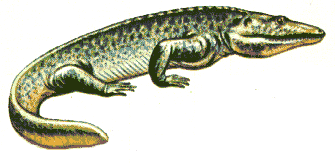 Eogyrinidae:
Palaeoherpeton, Pteroplax
Eogyrinidae:
Palaeoherpeton, Pteroplax
Range: Late Carboniferous to Middle Permian of Europe & North America.
Phylogeny: Embolomeri : (Proterogyrinus + Pholidogaster) + * : Diplovertebron + Pholiderpeton.
Image: Diplovertebron (~60 cm).
Note: The eogyrinids were one of a number of lineages of relatively large, long-bodied tetrapods that frequented late Carboniferous rivers and watercourses. MAK981014.
Links: Class:Amphibia. ATW020621.
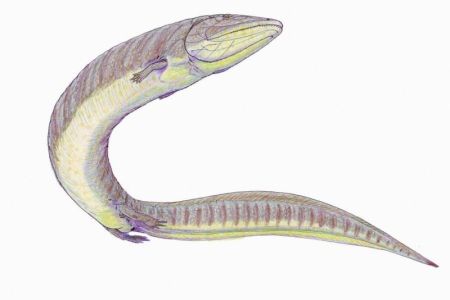 Pteroplax cornutus Hancock and Atthby 1868, life reconstruction, by Dmitry Bogdanov . Wikipedia, GNU Free Documentation/Creative Commons Attribution |
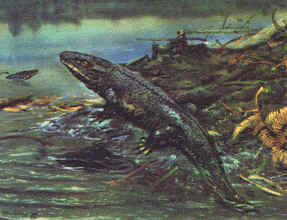 Diplovertebron:
D. punctatum Fritsch 1885
Diplovertebron:
D. punctatum Fritsch 1885
Range: Late Carboniferous (Moscovian? Bashkirian?) of Europe & North America.
Phylogeny: Eogyrinidae : Pholiderpeton + *.
Image: a rather imaginative reconstruction from Une page Web sur la période jurassique / A web page about jurassic period.
Links: Yale Peabody Museum: The Mural, Carboniferous & Devonian; Old, old reasons for hatred; Carbonifero (Italian); La galerie de la page jurassique : la faune aquatique et terrestre (French); ERA PALEOZÓICA (Spanish). ATW020621.
 Pholiderpeton:
(= Eogyrinus) P. atheyi Watson 1926, P scutigerum Huxley ??
Pholiderpeton:
(= Eogyrinus) P. atheyi Watson 1926, P scutigerum Huxley ??
Range: Late Carboniferous (Bashkirian [Westphalian B])
Phylogeny: Eogyrinidae : Diplovertebron + *.
Characters: ~200 cm; skull roof and palate only weakly attached [C02]; massive stapes [C02]; both pleurocentrum and intercentrum complete cylinders; anocleithrum present [C02].
Image: Pholiderpeton, (A) skull in dorsal view; (B) in palatal view; and (C) life reconstruction, from [C02], with (C) modified to show elements of internal skeletal features.
Links: Class-Amphibia
References: Clack (2002) [C02]. ATW030414.
| Page Back | Unit Home | Page Top | Page Next |
checked ATW040109